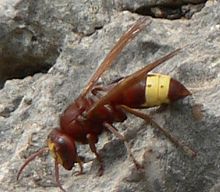Vespa (genus)
| Hornet | |
|---|---|
 |
|
| Oriental hornet, Vespa orientalis | |
| Scientific classification | |
| Kingdom: | Animalia |
| Phylum: | Arthropoda |
| Class: | Insecta |
| Order: | Hymenoptera |
| Family: | Vespidae |
| Subfamily: | Vespinae |
| Genus: |
Vespa Linnaeus, 1758 |
| Species | |
|
See text |
|
See text
Hornets (insects in the genera Vespa and Provespa) are the largest of the eusocial wasps, and are similar in appearance to their close relatives yellow jackets. Some species can reach up to 5.5 cm (2.2 in) in length. They are distinguished from other vespine wasps by the relatively large top margin of the head and by the rounded segment of the abdomen just behind the waist. Worldwide, there are 22 recognized species of Vespa, and three species of Provespa, which are unique amongst hornets in being nocturnal. Most species only occur in the tropics of Asia, though the European hornet (Vespa crabro), is widely distributed throughout Europe, Russia, North America and Northeast Asia. Wasps native to North America in the genus Dolichovespula are commonly referred to as hornets (e.g. baldfaced hornets), but are actually yellowjackets.
Like other social wasps, hornets build communal nests by chewing wood to make a papery pulp. Each nest has one queen, who lays eggs and is attended by workers who, while genetically female, cannot lay fertile eggs. Most species make exposed nests in trees and shrubs, but some (like Vespa orientalis) build their nests underground or in other cavities. In the tropics, these nests may last year-round, but in temperate areas, the nest dies over the winter, with lone queens hibernating in leaf litter or other insulative material until the spring.
Hornets are often considered pests, as they aggressively guard their nesting sites when threatened. This is particularly true for hornets nesting close to human habitation, as their stings are more dangerous than those of bees.
In Vespa crabro, the nest is founded in spring by a fertilized female known as the queen. She generally selects sheltered places like dark hollow tree trunks. She first builds a series of cells (up to 50) out of chewed tree bark. The cells are arranged in horizontal layers named combs, each cell being vertical and closed at the top. An egg is then laid in each cell. After 5–8 days, the egg hatches, and in the next two weeks, the larva undergoes its five stages. During this time, the queen feeds it a protein-rich diet of insects. Then, the larva spins a silk cap over the cell's opening and, during the next two weeks, transforms into an adult, a process called metamorphosis. The adult then eats its way through the silk cap. This first generation of workers, invariably females, will now gradually undertake all the tasks formerly carried out by the queen (foraging, nest building, taking care of the brood, etc.) with one exception: egg-laying, which remains exclusive to the queen.
...
Wikipedia
